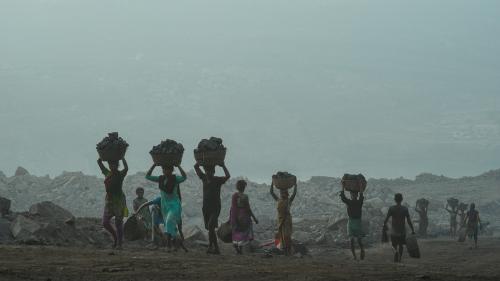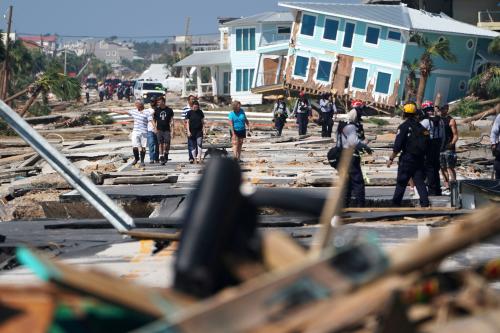At 2:46 p.m. this Sunday, March 11, my family and I will join millions of Japanese standing silently, perhaps at a Buddhist temple or a Shinto shrine. With heads bowed, we will remember the events of one year earlier, when our house swayed for nearly three minutes, the power died, and, in the Tohoku region a couple of hundred miles north, waves engulfed entire towns and two nuclear plants. We’ll relive the sorrow over the 19,000 lives lost in the Great East Japan Disaster, as the 9.0-magnitude earthquake and tsunami are known here.
It is all the more dispiriting, on this somber occasion, to contemplate how little the country’s prospects have changed. The disaster should have roused Japan from its lethargy once and for all. Instead, the nation’s malaise is back with a vengeance.
The Japanese have survived countless earthquakes and tsunamis, and built a spectacularly advanced economy atop the ashes of military defeat, giving them a reputation for rebounding from catastrophe. “In the past 20 years, never have I been more sanguine about prospects for Japan’s rebirth,” Yoichi Funabashi, one of the country’s leading journalists, wrote in a book of essays published shortly after the quake. But Funabashi also warned that the disaster had exacerbated Japan’s vulnerabilities. “Our choice,” he wrote, “is rebirth or ruin.”
If Japan were responding as it ought to, its economy would be poised to emerge from stagnation, spurred by the need to rebuild. And the national trauma would be inspiring politicians to overcome differences on issues vital to the future of the world’s fastest-aging society. But at the disaster’s first anniversary, Japan is floundering.
At first, Japan’s reaction was characteristically gritty. The anguish besetting the people of Tohoku — and the stoicism with which they bore it — generated an outpouring of compassion, support and national pride, encapsulated in the word kizuna, meaning “bonds,” which became a national catchphrase. Thus, when the government imposed rolling power outages, so much voluntary, round-the-clock energy saving occurred — with people donning extra clothing amid the cold — that the outages soon proved unnecessary.
That spirit has faded, however, as divisions have erupted over nuclear power. The national discussion of the country’s reliance on atomic energy has degenerated into farce as many people have become increasingly — and irrationally — preoccupied with how radiation from the crippled Fukushima Daiichipower plant might affect them. Large segments of the population are so petrified, and so militant in their fear, that most local governments outside Tohoku are refusing to accept for burial some of the millions of tons of rubble left by the tsunami. (And I’m talking about the remnants of smashed buildings and vehicles in other prefectures, not junk from the nuclear plant’s vicinity.)
In a town near where I live, officials rejected the debris, saying that even if the radiation emissions were zero, local farmers and fishermen might suffer from huu hyou higai — financial losses due to baseless rumors — just as many Tohoku producers are already. So much for kizuna.
Of Japan’s 54 atomic reactors — which previously supplied about 30 percent of the nation’s power — all but two are shut down, mostly for maintenance and safety checks, and many local authorities are balking at plans to restart plants in their jurisdictions. Although the government is scrambling to devise plans for boosting investment in renewable energy, such efforts will take decades. Amid steep increases in electricity bills, and uncertainty about the reliability of power supplies in general, the nation’s corporate giants — including Sumitomo Electric Industries, Mitsui Mining and Smelting, and the popular social networking service Gree — are warning that they will be forced to shift more operations abroad.
The hysteria about radiation reflects a breakdown in trust, as witnessed by endless media accounts quoting people who doubt the government’s monitoring of food and soil. This is lamentable; although officials disingenuously played down the possibility of a much worse accident at Fukushima Daiichi in the first days after the quake, reputable experts affirm the government’s major claim: that health risks are minuscule except in areas very close to the plant.
The public’s growing skepticism of authority is arousing more citizen involvement in politics, which could prove positive in the long run. But it increases the chances that imprudent ideas — such as mothballing all those nuclear plants — will prevail. Meanwhile, more serious political and economic problems are left to fester.
Tokyo’s political class, which was eager to appear unified after the disaster, is consumed anew with score-settling and power maneuvers of the sort that have given the country six prime ministers in the past five years. The upshot is a lengthy stalemate over the measures necessary to put Japan on sound long-term economic footing.
Prime Minister Yoshihiko Noda has proposed doubling the 5 percent consumption tax, an increase that would take effect only after several years so the economy could first gain strength. But the main opposition party, which favored a similar idea when in power, is refusing to help enact any such measure, insisting that elections should be held first. In the past few days, Noda and opposition leaders have hinted that they may be forging a compromise, but embittered rivals in Noda’s party are complaining that the tax hike is ill-timed and are threatening to break up the ruling coalition.
In contrast to the hapless situation in Tokyo are heartening scenes in Tohoku of life returning to some semblance of normalcy, though the region still faces staggering obstacles, with many of its younger residents moving elsewhere in search of jobs. Shelters that once accommodated half a million people are now closed; many of their former residents are living in temporary, government-provided housing. In coastal towns once inundated with seawater, vehicles traverse repaired roads, and shops have reopened.
Regardless of how such localities fare, however, their fortunes are only a small part of the effort needed to revitalize a national economy that was facing massive challenges long before March 11, 2011. Unfortunately, the disaster has heightened the most daunting problems. Reconstruction costs will swell the government’s $12 trillion debt, which stood at 212 percent of gross domestic product last year (compared with 165 percent for Greece and 128 percent for Italy). By 2013, as reconstruction spending kicks in, the debt burden in Japan will reach 227 percent of GDP, according to the Organization for Economic Cooperation and Development.
Japan has numerous strengths that crisis-plagued euro-zone countries do not, notably control over its currency and a vast pool of local savings from which to borrow. Still, Tokyo is not immune to a cataclysmic debt crisis. A failure to rein in future deficits could lead bond investors to lose confidence in Japan’s creditworthiness, plunging the economy into much worse trouble.
That’s where the need for revving Japan’s economic engine comes in. Although supercharged growth rates like those of the 1970s and ’80s are no longer conceivable, the nation’s vaunted living standards will be at serious risk if the economy keeps turning sluggish, as it has all too often.
The best way for a country to keep its debt-to-GDP ratio in check, after all, is to increase GDP rather than rely too much on austerity. And an even more compelling reason for Japan to improve its economic performance is its demographic problem: In just a couple of decades, a much smaller workforce will be supporting a ballooning number of elderly people. Without vastly greater resources in government and private hands, Japan won’t be able to adequately care for seniors while also preserving its enviable infrastructure, health system and lifestyle. The only way to generate those resources at a time when the workforce is dwindling is to make the economy more productive and efficient.
Good ideas abound for restoring Japan’s dynamism, such as creating more employment opportunities for women, all too many of whom stay out of the workforce because of poor promotion chances and a lack of affordable day care. But new economic pitfalls also loom as a result of last March’s disaster — in particular the danger that the nuclear crisis will spawn additional energy shortages, further subverting growth.
Few of the world’s peoples, if any, are as resourceful and concerned about the welfare of their compatriots as the Japanese. Perhaps it’s just a matter of time before they and their leaders put the country on a more promising path. After last year’s catastrophe, my admiration and affection for this country deepened to the point where I could happily envision my half-Japanese sons choosing to settle here. I just wish I felt confident that Japan will offer them, and the rest of their generation, the kind of prospects that would make that choice attractive.



Commentary
Op-edLast Year’s Tragedy Failed to Rouse Japan from Its Stagnation
March 12, 2012